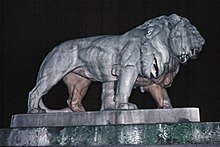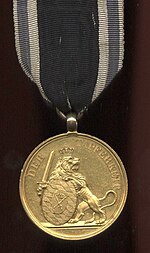Bavarian lion
The Bavarian lion is a multiple component of the Bavarian state coat of arms . He is also a symbol of the Free State of Bavaria , among other things on monuments and awards.
National coat of arms
Two gold, red-armored lions frame the coat of arms as shield holders . In the five fields , the parts of Bavaria , which has been enlarged since the time of the kingdom , are honored.
The “golden lion” in the black field represents the Upper Palatinate administrative region , it is the Palatinate lion . The red and white rake stands for the three Franconian administrative districts of Middle , Upper and Lower Franconia , the blue panther for Lower and Upper Bavaria , and three black lions symbolize the administrative district of Swabia .
The heart shield contains the white and blue Wecken , known colloquially as lozenges , that go back to the Counts of Bogen and were taken over by the Wittelsbachers after the fiefdom moved in .
history
The lion came into the Wittelsbach family as a heraldic animal in 1214 . After the line of the Count Palatinate of the Electoral Palatinate became extinct in the male line , King Friedrich II granted the Electoral Palatinate title to Otto II , the son of Ludwig des Kelheimer from the Wittelsbach family. Otto was married to the Count Palatine daughter in 1212 at the age of six. As long as he was still a minor, Ludwig ruled for him. Otto could not take office until 1228. In 1229 he introduced an official coat of arms for the Electoral Palatinate with a golden lion on a black background, after earlier Electors of the Palatinate had already included various lions in their private coats of arms.
The Wittelsbacher subsequently took over the lion as heraldic animal for all old Bavarian and Palatinate lines. The diamonds were formally added in 1242 when the Counts of Bogen died out and were inherited by the Wittelsbach family. A combination coat of arms consisting of diamonds and lions is first recorded in 1330: In a shield divided into four there are diagonally two lions and two diamond fields. This coat of arms was continued in different variations by both lines.
The newly introduced Kingdom of Bavaria took over the lion in the first coat of arms in 1806, but gave it up again in the same year when a second coat of arms was introduced. Lions were then only used as shield holders for the representation of the large coat of arms . It was only Ludwig I who again emphasized the regional reference of his rule, which is why he introduced a new unified coat of arms in 1835 , which took up the Palatinate lion again. This remained in use until the end of the monarchy in 1918. The Free State of Bavaria has also had the Palatinate Lion since 1923; in the version since 1950, it no longer stands for the Rhine Palatinate, but for the Upper Palatinate administrative region .
It is also known that the Wittelsbachers kept living lions in various castles and fortresses. A lion master has been known as an employee in Munich's Alten Hof since 1491, and in 1493 Hartmann Schedel reported on the birth of young lions there in the Schedel Chronicle named after him. The animals can be traced back to Munich for at least 250 years and were also used as valuable gifts from the dukes. In 1551 two animals were given away to the court of the elector in Heidelberg, in 1554 one to the count palatine in Neuburg. In 1580 a lion house was built at the Alter Hof in Burgstrasse and in 1614 an Augsburg patrician reported about a lion that was kept in the Alter Hof. The last proven lion master died in 1734. A former lion's moat has been preserved in Landshut Trausnitz Castle .
Monuments

- The two main entrances to the Munich Residence have been guarded by two lions each since 1616.
- The Bavarian lion rests at the foot of the Otto column in Ottobrunn, which was unveiled in 1834 .
- A stone lion stands to the left and right of the stairway to the Munich Feldherrnhalle .
- The Bavarian lion is placed next to the Bavaria statue erected between 1843 and 1850 above the Theresienwiese.
- The Lindau harbor entrance is bordered on the east by a statue of the lion.
- The lion has been sitting on the Oberland monument in Waakirchen since 1905 .
- Lion monument near Bad Abbach , 1794/96
Awards
- The back of the Bavarian Bravery Medal is decorated with an image of the Bavarian lion.
- The "Bavarian Lion" is an award from the Bavarian Ministry of Agriculture .
- Every year , the Bavarian Ministry of Economic Affairs honors particularly fast-growing medium-sized companies with the Bavarian best 50 award .
- Prize plate of the Gau winners for the lion of the Bavarian Prime Minister .
additional
- Until its dissolution, the Pioneer Training Brigade 60 had the designation "Bavarian Lion".
- The football players of TSV 1860 Munich are also called "Munich Lions" or "Lions" for short.
literature
- Katharina Heinemann, Matthias Memmel: Lions from Bavaria's palaces and castles. Special edition. Bavarian State Ministry for Finance, Regional Development and Homeland, public relations ao, Munich ao 2014.
- Wilhelm Volkert : The pictures in the coat of arms of the Wittelsbacher. In: Wittelsbach and Bavaria. Volume 1: Hubert Glaser (Ed.): The time of the early dukes. From Otto I. to Ludwig the Bavarian. Part 1: Contributions to Bavarian history and art. 1180-1350. Hirmer et al., Munich et al. 1980, ISBN 3-7774-3180-X , pp. 13-38.
- Wilhelm Volkert: The coat of arms of the state of Bavaria ("Insignia armorum terrae Bavariae"). In: Journal for Bavarian State History . Vol. 44, 1981, pp. 675-692, ( digitized version ).
Web links
Individual evidence
- ↑ Katharina Heinemann, Matthias Memmel: Lions from Bavaria's palaces and castles. 2014, p. 21 f.
- ↑ Katharina Heinemann, Matthias Memmel: Lions from Bavaria's palaces and castles. 2014, pp. 33–36
- ↑ Enno Burmeister: The historical development of the old court in Munich. Buchendorfer, Munich 1999, ISBN 3-934036-07-4 , p. 68 and endnotes.
- ↑ Katharina Heinemann, Matthias Memmel: Lions from Bavaria's palaces and castles . Bavarian State Ministry for Finance, Regional Development and Homeland 2014, p. 71
- ^ Süddeutsche Zeitung : Return of the Lions , March 26, 2014, page 31
- ↑ Bavarian Lion for former BBV top representatives. (No longer available online.) July 19, 2012, archived from the original on September 24, 2015 ; Retrieved June 26, 2015 . Info: The archive link was inserted automatically and has not yet been checked. Please check the original and archive link according to the instructions and then remove this notice.
- ↑ Price platln around the Bavarian Lion
- ↑ Promise ceremony in Böhmfeld



